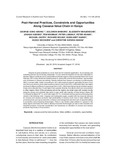Post-harvest practices, constraints and opportunities along cassava value chain in Kenya

View/
Date
2016Author
Abong’, George O
Shibairo, Solomon
Wanjekeche, Elizabeth
Ogendo, Joshua
Wambua, Tom
Lamuka, Peter
Arama, Peter
Okoth, Michael
Mulwa, Richard
Kamidi, Margaret
Mcosore, Zadoc
Masha, Christine K
Type
ArticleLanguage
enMetadata
Show full item recordAbstract
Despite its great potential as a food, feed and for industrial application, its processing and marketing remains economically unexploited. A cross-sectional baseline survey was undertaken in Western (Migori and Busia) and Coastal (Kilifi and Kwale) regions of Kenya between March 2013 and February 2014 using structured questionnaires to assess the post-harvest practices, opportunities and constraints in cassava processing. Results indicate that cassava processing is predominantly (58%) a women affair, males accounting for 42% with modal processors age being 32 years. Flour was the most common processed cassava product in the Coast (33%) while dried chips was highly produced in Migori and Busia in equal proportion of 43%. Other important products included cassava crisps and composite flour. Coast region had a greater diversity of products which are none existent in other regions. Most of the processing across the regions are small scale with workers mostly being the owners and activities take place in open yards with majority of these being in Busia (85 %) followed by Migori (67 %) and Coast region (57 %). Constraints during cassava processing were ranked in the following order: irregular and inadequate supply coupled with low seasonal demand for cassava and cassava products; high perishability of cassava roots; lack of value addition and processing tools; poor group dynamics, cohesion and management structure; lack of capacity building in production and processing technologies. There is very limited value addition to cassava in the study regions and hence the need to develop innovative technologies as well as new domestic and industrial products. Consumer sensitization and awareness on utilization of cassava and cassava products may be key to its promotion
URI
Abong, G. O., Shibairo, S., Wanjekeche, E., Ogendo, J., Wambua, T., & Lamuka, P. (2016). Post-Harvest Practices, Constraints and Opportunities Along Cassava Value Chain in Kenya. Current Research in Nutrition and Food Science Journal, 4(2), 114-126.http://hdl.handle.net/11295/100765
Citation
Abong, G. O., Shibairo, S., Wanjekeche, E., Ogendo, J., Wambua, T., & Lamuka, P. (2016). Post-Harvest Practices, Constraints and Opportunities Along Cassava Value Chain in Kenya. Current Research in Nutrition and Food Science Journal, 4(2), 114-126.Publisher
University of Nairobi
